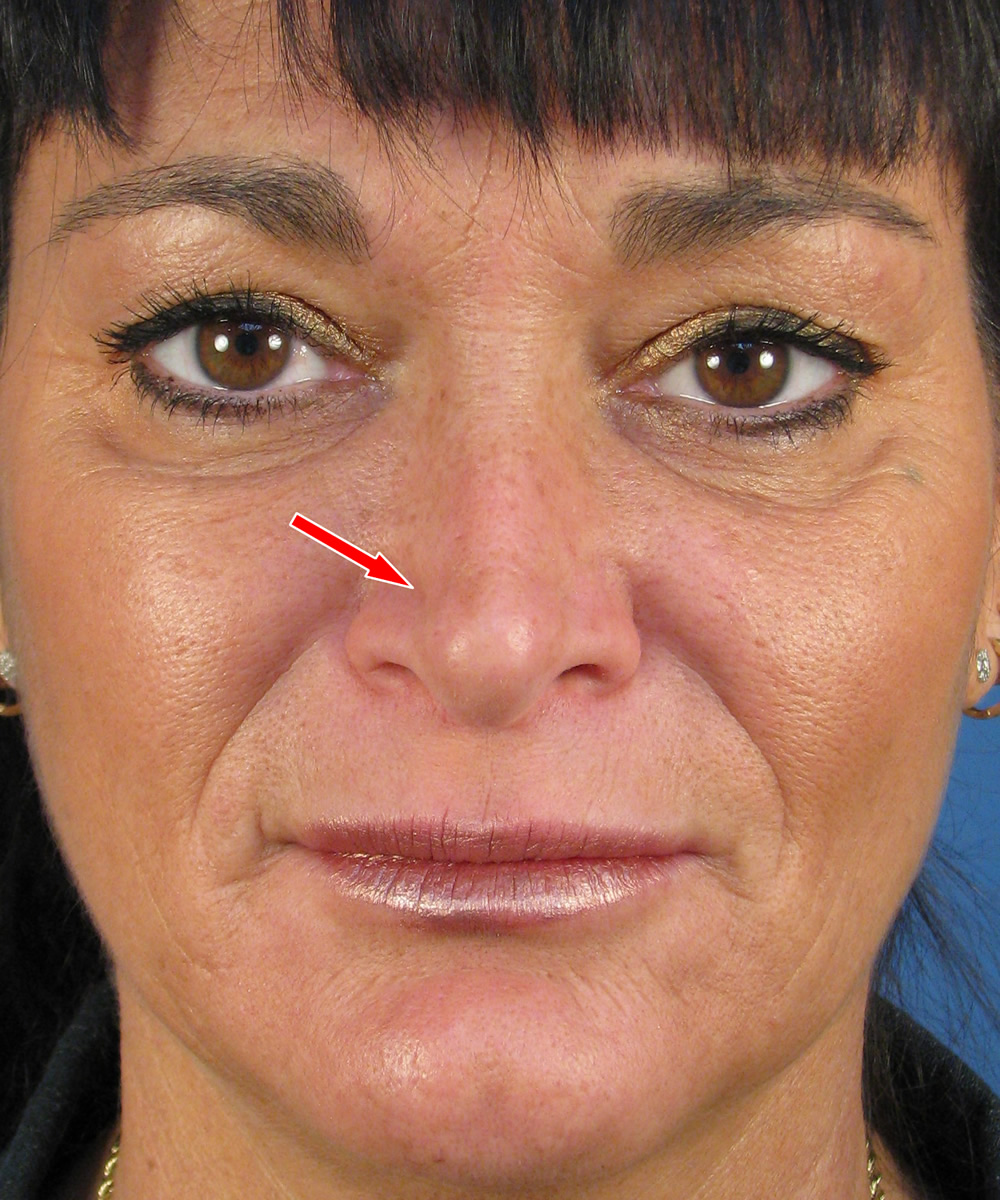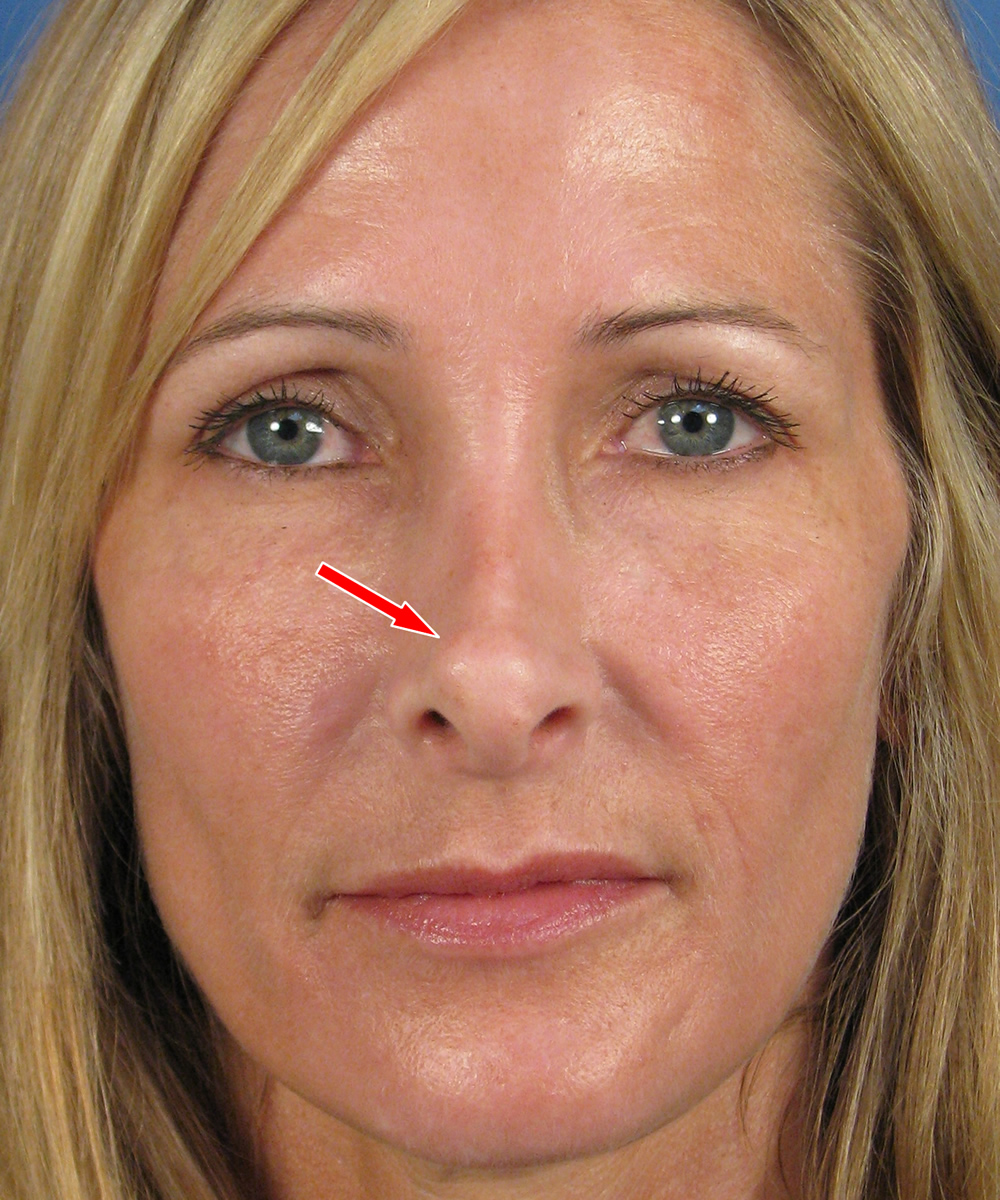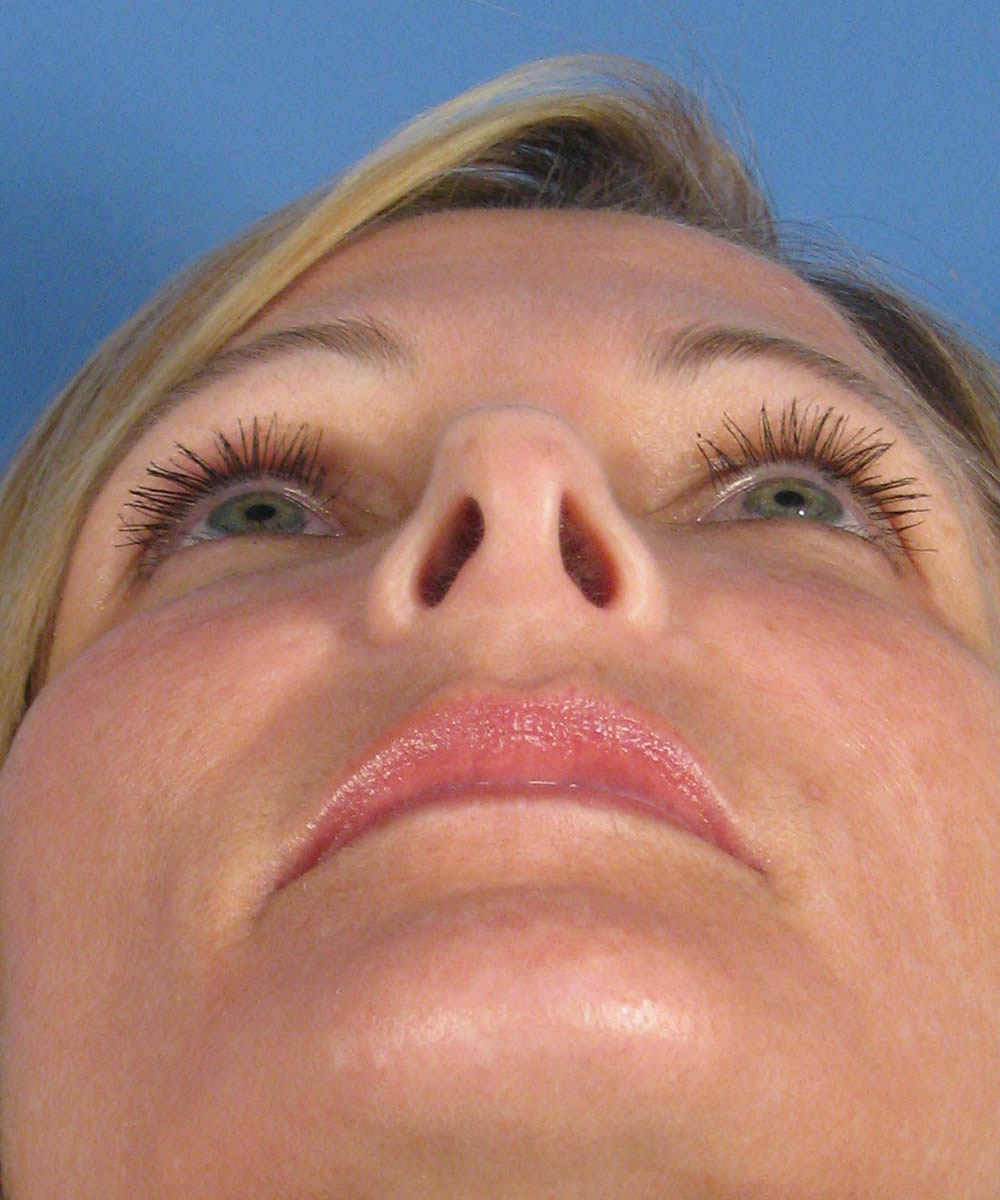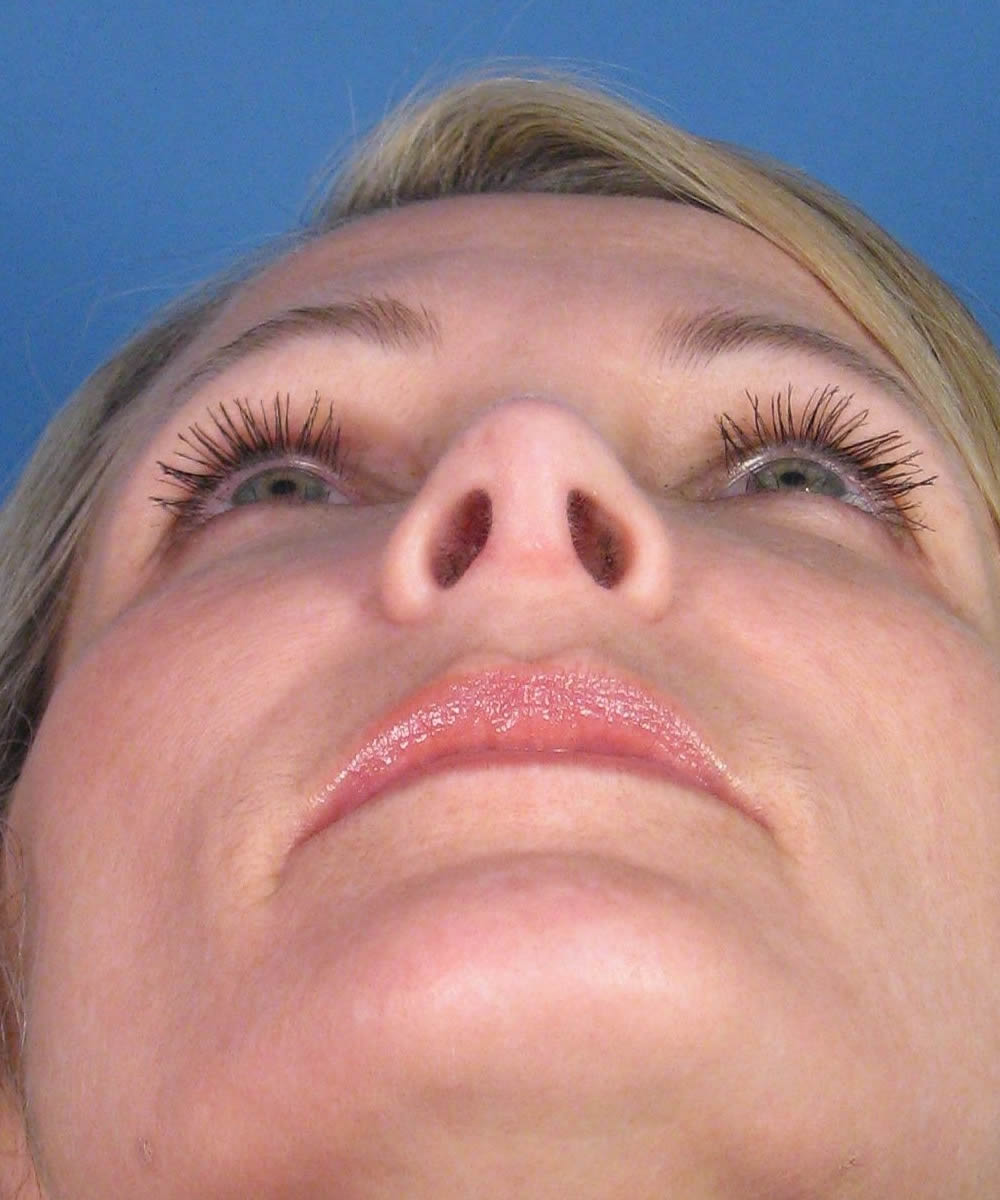A pinched nasal tip refers to a nose that is excessively narrowed in the region of the tip. This type of nasal abnormality can arise as a congenital problem – meaning the patient was born with this – or as a result of having had prior unsuccessful rhinoplasty surgery. In most cases, rhinoplasty patients presenting with a pinched nasal tip have had prior surgery that contributed to the problem. It is much less common to see patients who have a congenitally pinched nasal tip.
Why Does The Nose Pinch?
To understand why the nose pinches inward at the nasal tip, you must first have a good understanding of the nasal anatomy. Please refer to our online rhinoplasty tutorial chapter on nasal analysis to familiarize yourself with the pertinent anatomy and surface landmarks of the nose.
The tip of the nose is normally comprised of the paired lower lateral cartilages along with the lower portion of the septum. In reality, the lower lateral cartilages are the structures that more directly contribute to the shape of the nasal tip. This anatomy is depicted below and shaded red to show the pair of lower lateral cartilages in their normal position and shape. As you can see from the diagrams, particularly the base view from below the nose, normal lower lateral cartilages create what is called a ‘soft triangle’ shape to the nasal tip. This means that the tip is overall a triangular shape but does not have any sharp angulations. This is precisely what gives the ideal nasal tip a soft, yet defined appearance.

 When the lower lateral cartilages deviate from this ideal position and shape, the appearance of the nasal tip will follow suit. In the case of a pinched nasal tip, the lower lateral cartilages are somehow weakened or compromised, resulting in collapse of the nasal tip support on one side or another. As noted above, this type of abnormality can be either congenital or a result of prior rhinoplasty surgery.
When the lower lateral cartilages deviate from this ideal position and shape, the appearance of the nasal tip will follow suit. In the case of a pinched nasal tip, the lower lateral cartilages are somehow weakened or compromised, resulting in collapse of the nasal tip support on one side or another. As noted above, this type of abnormality can be either congenital or a result of prior rhinoplasty surgery.
So what happens to the lower lateral cartilage when the nasal tip is pinched? In most cases, the nose pinches inward because the lower lateral cartilage is too narrow to support the sides of the nasal tip. This concept is shown below in a series of rhinoplasty diagrams.

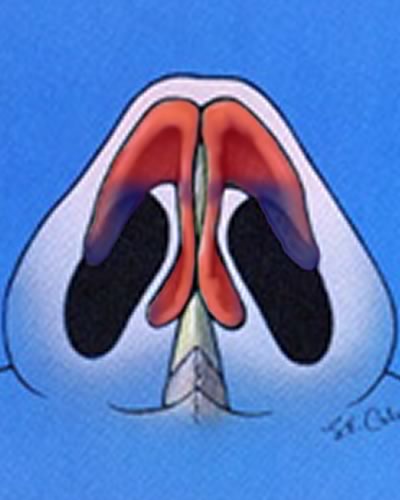 In many cases of rhinoplasty, the plastic surgeon attempts to narrow the appearance of the tip in the hopes of providing more definition to the nose. One technique that is still commonly used in rhinoplasty and revision rhinoplasty today is removal of some of the cartilage around the tip region. This includes a technique called cephalic trimming, where the cartilage along the cephalic border (the side of the lower lateral cartilage closer to the eyes) of the nasal tip is removed. In the adjacent rhinoplasty diagrams, this cartilage removal is represented by the blue shaded area where there used to be red (cartilage). The idea is that this cartilage is contributing to a rounded or bulbous look to the nasal tip. By removing this strip of cartilage during a rhinoplasty procedure, the tip can be made more narrow and, thus, more defined.
In many cases of rhinoplasty, the plastic surgeon attempts to narrow the appearance of the tip in the hopes of providing more definition to the nose. One technique that is still commonly used in rhinoplasty and revision rhinoplasty today is removal of some of the cartilage around the tip region. This includes a technique called cephalic trimming, where the cartilage along the cephalic border (the side of the lower lateral cartilage closer to the eyes) of the nasal tip is removed. In the adjacent rhinoplasty diagrams, this cartilage removal is represented by the blue shaded area where there used to be red (cartilage). The idea is that this cartilage is contributing to a rounded or bulbous look to the nasal tip. By removing this strip of cartilage during a rhinoplasty procedure, the tip can be made more narrow and, thus, more defined.
 Unfortunately, when a rhinoplasty surgeon is too aggressive and removes excessive cartilage in this area, they are diminishing the structural support of the natural nasal tip. In some rhinoplasty patients, this can amount to as much as one-third of the native cartilage support of the nasal tip that is being removed. If you look at the diagrams above, you can easily appreciate that removing this amount of cartilage (the blue shaded segment) is going to compromise the tip support to some degree. Yes, you may produce a ‘more defined nasal tip,’ but at what cost? In cases where there is insufficient lower lateral cartilage left behind, the nasal tip may not have enough structural support to maintain proper shape. It is these cases where a pinched nasal tip can result following a nose reshaping procedure. This is the type of complication from rhinoplasty that is not going to be appreciated on the operating room table at the time of the surgery. Instead, this type of rhinoplasty deformity will appear months down the road of recovery once the swelling resolves and the skin shrink wraps down. The adjacent rhinoplasty diagram shows what happens to the lower lateral cartilage following removal of excessive amounts of cartilage. The side wall of the nasal tip begins to pinch inward since the remaining cartilage is not strong enough to support the sides of the tip and the nostril rims. This pinching effect occurs to the side of the actual tip where the nose transitions out to the side of the nostrils. The depression that results can be an obvious stigma of having had a prior unsuccessful rhinoplasty surgery.
Unfortunately, when a rhinoplasty surgeon is too aggressive and removes excessive cartilage in this area, they are diminishing the structural support of the natural nasal tip. In some rhinoplasty patients, this can amount to as much as one-third of the native cartilage support of the nasal tip that is being removed. If you look at the diagrams above, you can easily appreciate that removing this amount of cartilage (the blue shaded segment) is going to compromise the tip support to some degree. Yes, you may produce a ‘more defined nasal tip,’ but at what cost? In cases where there is insufficient lower lateral cartilage left behind, the nasal tip may not have enough structural support to maintain proper shape. It is these cases where a pinched nasal tip can result following a nose reshaping procedure. This is the type of complication from rhinoplasty that is not going to be appreciated on the operating room table at the time of the surgery. Instead, this type of rhinoplasty deformity will appear months down the road of recovery once the swelling resolves and the skin shrink wraps down. The adjacent rhinoplasty diagram shows what happens to the lower lateral cartilage following removal of excessive amounts of cartilage. The side wall of the nasal tip begins to pinch inward since the remaining cartilage is not strong enough to support the sides of the tip and the nostril rims. This pinching effect occurs to the side of the actual tip where the nose transitions out to the side of the nostrils. The depression that results can be an obvious stigma of having had a prior unsuccessful rhinoplasty surgery.
Breathing Problems From A Pinched Nasal Tip
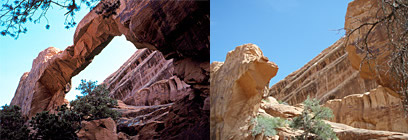
There are also functional implications from having a pinched nasal tip above and beyond the cosmetic concerns. Normally the lower lateral cartilage helps to maintain an patent airway, or breathing passage, in terms of the nostril opening. Think of the normal lower lateral cartilage as the arched roof of the nostril opening. If this support is compromised to a significant degree, the roof will eventually collapse. This is seen more graphically in the adjacent photo showing what happens in nature when an arched contour looses its integrity to the point of collapse. 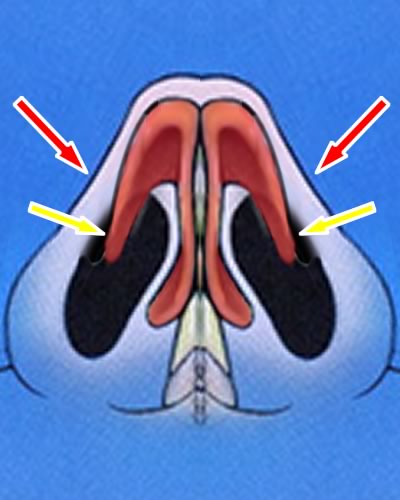 In terms of the nostril opening, the remaining, weakened lower lateral cartilage also collapses inward. As shown in the adjacent diagram, the cartilage is no longer positioned out to the side providing support to the roof of nostril rim. Instead, it begins to drop into the nasal airway on both sides (yellow arrows showing cartilage dropping into the black nasal airway), blocking the breathing passage. So, in addition to cosmetic issues with the nose, these rhinoplasty patients, unfortunately, also present with trouble breathing through the nose.
In terms of the nostril opening, the remaining, weakened lower lateral cartilage also collapses inward. As shown in the adjacent diagram, the cartilage is no longer positioned out to the side providing support to the roof of nostril rim. Instead, it begins to drop into the nasal airway on both sides (yellow arrows showing cartilage dropping into the black nasal airway), blocking the breathing passage. So, in addition to cosmetic issues with the nose, these rhinoplasty patients, unfortunately, also present with trouble breathing through the nose.
Appearance Of The Pinched Nasal Tip
The following real life rhinoplasty patient photos visually demonstrate what the nose looks like when the tip begins to pinch inward. These are patients who had previously undergone rhinoplasty surgery to reshape their nose. The rhinoplasty, performed by a different facial plastic surgeon, was unsuccessful in that the nasal tip became pinched following surgery. They had each consulted with our San Diego facial plastic surgery office to consider a revision rhinoplasty, or secondary rhinoplasty, surgery.
On the frontal view of the nose, the red arrow points to the zone of maximal collapse, or pinching. You can appreciate the fact that there is a drop in contour when going from the nasal tip out to the side of the nostril. Usually this results in an abnormal shadow that is cast in these rhinoplasty patients. And in most cases, this pinching is asymmetric, or in other words, different from side to side. On the base view of the nose (from underneath), the red arrow also points to the zone of maximal collapse, or pinching. In fact, compare these real life rhinoplasty patients’ base view with the diagram above, showing the pinched nasal tip. You can see precisely where the nose pinches inward as was demonstrated in the diagram. Instead of having a gentle, convex contour from the nasal tip out to the side of the nostril, there is a notable depression due to the pinching and collapse of the cartilage.
Rhinoplasty To Correct The Pinched Nasal Tip
Rhinoplasty surgery to correct a pinched nasal tip is intended to target the lower lateral cartilage where there is maximal collapse. This usually requires cartilage grafting to rebuild the support mechanism around the nostril. Cartilage grafting is typically needed since the root of the problem is that too much cartilage was removed or was never present (in congenital cases). In patients where the septal cartilage is present in sufficient quantity, this can be used to create the cartilage grafts. In rhinoplasty patients who do not have enough septal cartilage for grafting purposes, ear cartilage (also known as auricular cartilage) is a fairly good alternative in most instances.
 The goal is to create a graft that is relatively straight and rigid that can span the distance from the nasal tip out to the side of the nostril. In the adjacent rhinoplasty diagram, this is shown visually. The blue rectangles represent the actual cartilage grafts that are placed. As you can see, they need to be fairly linear in shape with sufficient rigidity to resist collapse – much like a steel beam. In addition, the cartilage grafts need to have a adequate length to span the entire zone of maximal collapse plus an overlap onto natively stable structures. As is depicted in the diagram, the cartilage grafts are usually sutured (sewn) into place (white suture loop with knot). With precise placement and positioning of the cartilage graft, a rhinoplasty surgeon can carefully ‘pull’ the collapsed, lower lateral cartilage outward. Think of a bird spreading their wings. This type of meticulous cartilage grafting can restore a more esthetically ideal contour to the nasal tip and mitigate unwanted shadowing. As you can see in the diagram, the nasal passageway is also improved as a byproduct of this type of rhinoplasty repair.
The goal is to create a graft that is relatively straight and rigid that can span the distance from the nasal tip out to the side of the nostril. In the adjacent rhinoplasty diagram, this is shown visually. The blue rectangles represent the actual cartilage grafts that are placed. As you can see, they need to be fairly linear in shape with sufficient rigidity to resist collapse – much like a steel beam. In addition, the cartilage grafts need to have a adequate length to span the entire zone of maximal collapse plus an overlap onto natively stable structures. As is depicted in the diagram, the cartilage grafts are usually sutured (sewn) into place (white suture loop with knot). With precise placement and positioning of the cartilage graft, a rhinoplasty surgeon can carefully ‘pull’ the collapsed, lower lateral cartilage outward. Think of a bird spreading their wings. This type of meticulous cartilage grafting can restore a more esthetically ideal contour to the nasal tip and mitigate unwanted shadowing. As you can see in the diagram, the nasal passageway is also improved as a byproduct of this type of rhinoplasty repair.
Revision Rhinoplasty For Pinched Nasal Tip Before And After Photos
The following clinical examples are revision rhinoplasty patients of ours from San Diego. In these particular patients, auricular cartilage grafting was required to rebuild the pinched nasal tip since there was insufficient septal cartilage available for this purpose. The most dramatic change can be seen in the base view of their nose. It is from this angle that one can easily see how rebuilding the lower lateral cartilage support can impact the overall shape of the nasal tip. Whereas these patients had pinching of the nasal tip prior to revision rhinoplasty, they now have restoration of a soft triangular shape to the nose. You can also easily imagine how much better their nasal breathing is following the revision rhinoplasty with cartilage grafting. The real trick is trying to restore enough structure support to the nasal tip while maintaining a nice natural look to the nose. This is the type of revision rhinoplasty surgery that should only be tackled by plastic surgeons with advanced training in revision rhinoplasty technique. When performed by an experienced, knowledgeable revision rhinoplasty expert, this type of challenging, complicated nose reshaping procedure can be done with excellent results.

